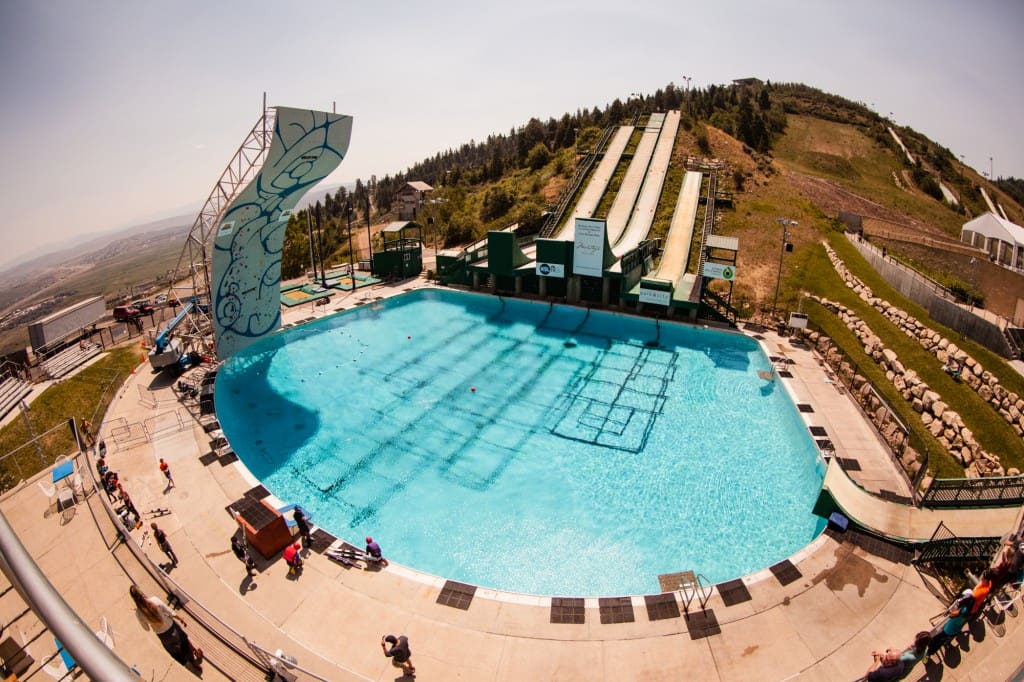by James Lucas
I grabbed the sloping hold three times but failed to commit. The twenty foot fall into the water below scared me. As I pawed at the hold, I thought about how I swam like a stone. My legs quivered a bit. I down climbed and stepped off the wall, never committing to a move that I knew I was capable of.
The Psicocomp Wall in Park City offered a great opportunity to climb outside and escape a bit of the oppressive Utah heat. A half dozen routes from 5.9 to 5.13 climbed half way up the fifty foot wall. The routes were a step in preparation for the second annual Psicocomp, which arrives in Park City on August 8th. The comp originated with an idea from Chris Sharma and Mike Call, who were deep water soloing in Malorca Spain. When the opportunity arose to use the ten foot deep Olympic pool at the Park City training area, the pair seized the opportunity to build a 55 foot wall over the water with Walltopia.
Within six months, the Psicocomp established an amazing event. 5,000 people watched live with and an audience of 55,000 viewed the excitement online, making the Psicocomp the most viewed climbing competition in history. This year’s Psicocomp promises to be better with the increased sponsorship and support. A crew of announcers will run a play by play during the event and cameras will capture the action from above the climbers, from under water and from across the wall.
Spanish climbing legend Dani Andrada and the Godfather of Deep Water Soloing, Miguel Riera will return to set the 5.13 route for women and 5.14 route for men. They will be setting for a much deeper and more elite field of climbers including Chris Sharma, Nalle Hukatavalle, Ashima Shiraishi, Sasha Digulian and others. These climbers will be competing for 30,000 in cash. The style of the climbing is “Not like a route climbing comp,” said Mike Call. “Or like a long boulder problem comp. It’s a new comp genre in terms of length and fitness. If you want to win you have to climb the wall multiple times and faster than the other person.” The climbers will be racing elimination style. The climber who climbs higher on the wall faster advances.
Beyond the difficulty of the climbing, the climbers will face the challenge of climbing so high above the water and being very afraid. Fear can be described in two types: Rational and Irrational. Rational fear is when you are in an actual dangerous situation like you’re in over your head on hard climbing with no gear. Irrational Fear is when you get scared for no reason like when you’re sport climbing and can’t climb above your bolt. Irrational fear can be quite frustrating because despite knowing that a situation is safe, like taking a twenty foot fall into water, it is psychologically debilitating.
“One of the really useful things I think was to approach things mindfully. As in to be fully aware of what you’re doing and why,” said noted free soloist Alex Honnold when asked about how he deals with fear. “So if something is dangerous, you evaluate it and decide whether or not you actually want to proceed. And if it seems too dangerous, you retreat with no doubts.”
There are times when even Honnold gets scared though. I asked him about how he manages his fear. “I don’t think it’s so much about managing my fear, as not getting fearful to begin with. With routes like Ambrosia (a forty foot highball in Bishop California) and long solos you deal with all the uncertainty and fear before you start. You manage all that stuff on the ground. Then when you climb the route it’s already taken care of. So while you’re climbing, you don’t get scared,” said Honnold.“But sometimes when I’m onsight soloing or even just doing stuff on gear I’ll get gripped for whatever reason. Then I just do what everybody else does, take some deep breaths and try to keep it together.”
A few of the other climbers at the pool took practice falls from lower heights. They became used to the idea of falling into the water and realized that much of their hesitance in climbing was from Irrational Fear. I noticed that climbing faster would get me to the crux less pumped and I’d be more prepared for the crux. “Fatigue makes cowards of us all,” said Vince Lombardi.
I fell in a few times low on the wall and then I stared at the wall. My buddy, Mason encouraged me to “just go for it.” Before leaving the ground, I chalked my hands thoroughly and committed to climbing well. I moved high on the wall, grabbed the sloper and moved into the next hold. I fought through a series of good pinches towards the top. I imagined that I was competing in the Psicocomp. I threw for the last hold. I came up a few inches short. I screamed and splashed into the water 25 feet below. I swam back up, ready to try again.


